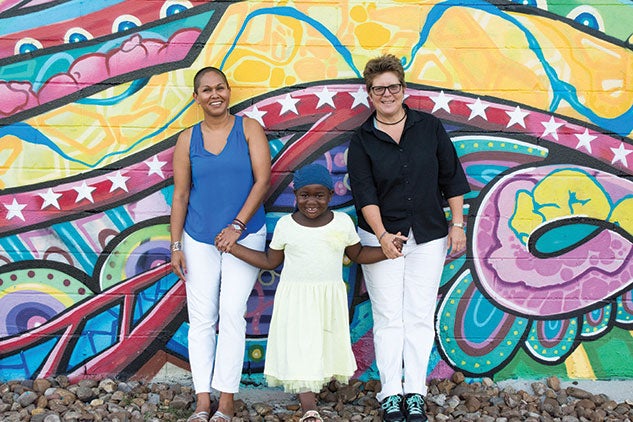Author Q&A: Nishta Mehra

Nishta Mehra ’05 is brown-skinned. Her wife, Jill Carroll ’94, is white. Their adopted child, Shiv, who was born a boy but identifies as a girl, is black. And their family dynamic proves endlessly perplexing to the people standing near them in line at the grocery store. After fending off enough intrusive questions — “Are you his nanny?” “Does he look like daddy?” — Mehra was tempted to print a set of passive-aggressive note cards that say: “The next time you’re tempted to ask deeply personal questions of complete strangers, please try to remember that the world and its possibilities are far bigger than your little narrow purview attests. Check your assumptions. We don’t owe you an explanation. Neither does anyone else.”
Mehra’s book, “Brown White Black,” is not, therefore, an explanation. Her life, and her family, are not here to serve as an educational experience for the rest of us. Instead, her essays grapple with the idiosyncrasies of the American social structure that make many of us, especially if we are white and heterosexual, feel threatened by deviations from what we see as the social norm — and so entitled to answers that we demand them from a stranger who is just trying to get through the checkout line at Whole Foods with her kid. But since she’s open to talking about difficult subjects, we asked her some intrusive questions anyway.
How is Shiv’s experience of growing up black in Houston different from your experience of growing up brown in Memphis?
I think there’s quite a bit of overlap. A key difference is the fact that Shiv is part of a mixed-race family; she’s the only black person in our family. At the same time, she sees many more representations of blackness in the world around her than I did of brownness growing up. Shiv’s school environment and neighborhood in Houston are much more diverse than mine were growing up in Memphis.
After Shiv told you she was “actually a girl,” you describe the period of “parental panic” that ensued as you worried about the challenges her future might hold. Has that panic subsided?
The panic is always there, under the surface; it gets triggered from time to time, but I try not to focus on it. I think I learned a bit about this emotional experience in becoming a parent of a black child in America — that panic is also always under the surface, easily accessed but crippling if you focus on it. The panic may be justified, but it doesn’t serve anyone, certainly not Shiv. And on a daily basis, what I am mostly struck by is how fully self-expressed and embodied my child is, which is a beautiful thing to see as a parent. And practically, though we may have a seemingly unusual family makeup, we also deal with fairly universal concerns like packing lunch, managing play dates, birthday party RSVPs and bedtime. Those kinds of things help you get from one day to the next.
 You describe the term “post-racial” as a fantasy — and an absurdity — and race relations in America seem to have only backslid lately. The same seems true for gay and transgender rights. Are there reasons to be hopeful for the future?
You describe the term “post-racial” as a fantasy — and an absurdity — and race relations in America seem to have only backslid lately. The same seems true for gay and transgender rights. Are there reasons to be hopeful for the future?
As a teacher, I have become increasingly convinced that the most important thing I can do in my classroom is push my students — and myself, let’s be clear! — to look at and talk about difficult things, to disagree while really hearing each other. I believe that so much of what we are seeing right now is the result of our tendency to turn away from those hard topics, or the ways in which we will gloss over the hardest parts or push to get to the “good news” of how we as a society have improved.
This means that our students — who eventually become our adults, our voters, our citizens — lack the skills to move around inside of ambiguity, to handle complexity and nuance, to discuss topics that don’t have easy answers. We have to do this hard work! So anyone who is practicing and/or modeling how to do that work, whether at the individual or collective level, gives me hope right now.
— Jennifer Latson
